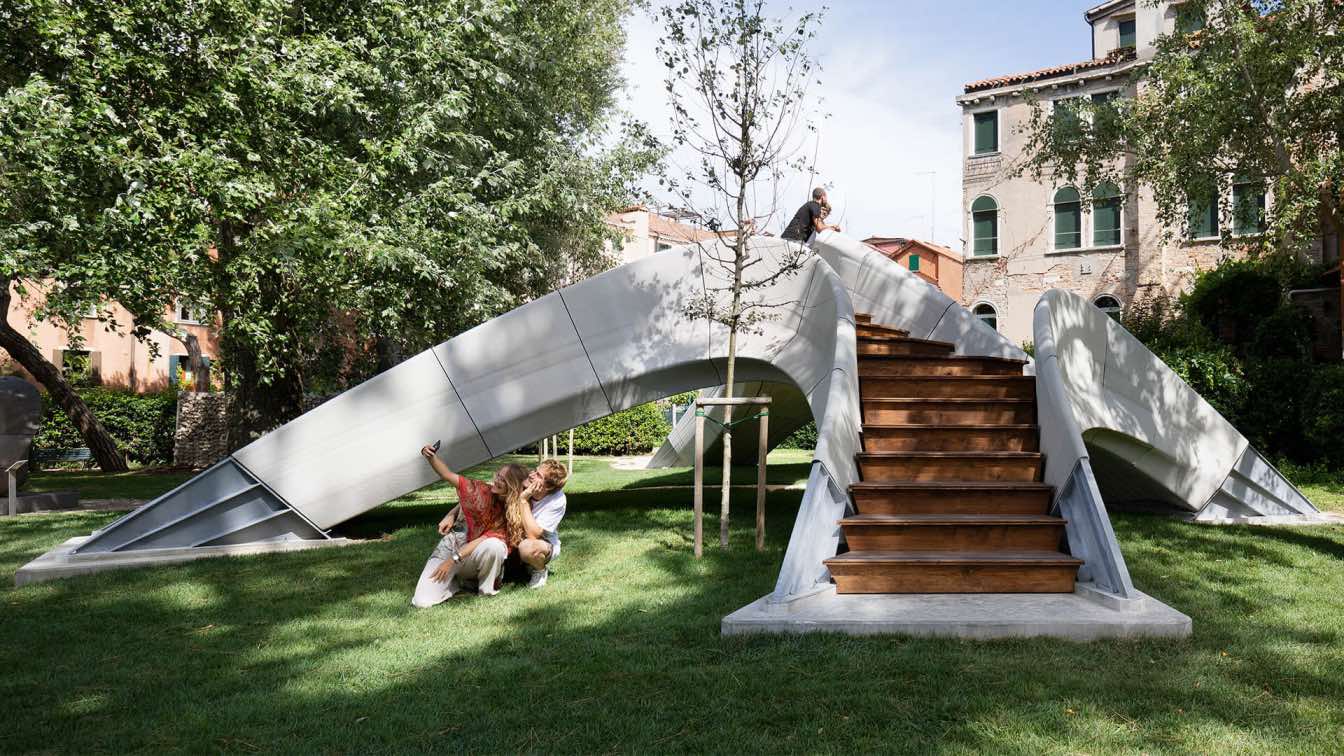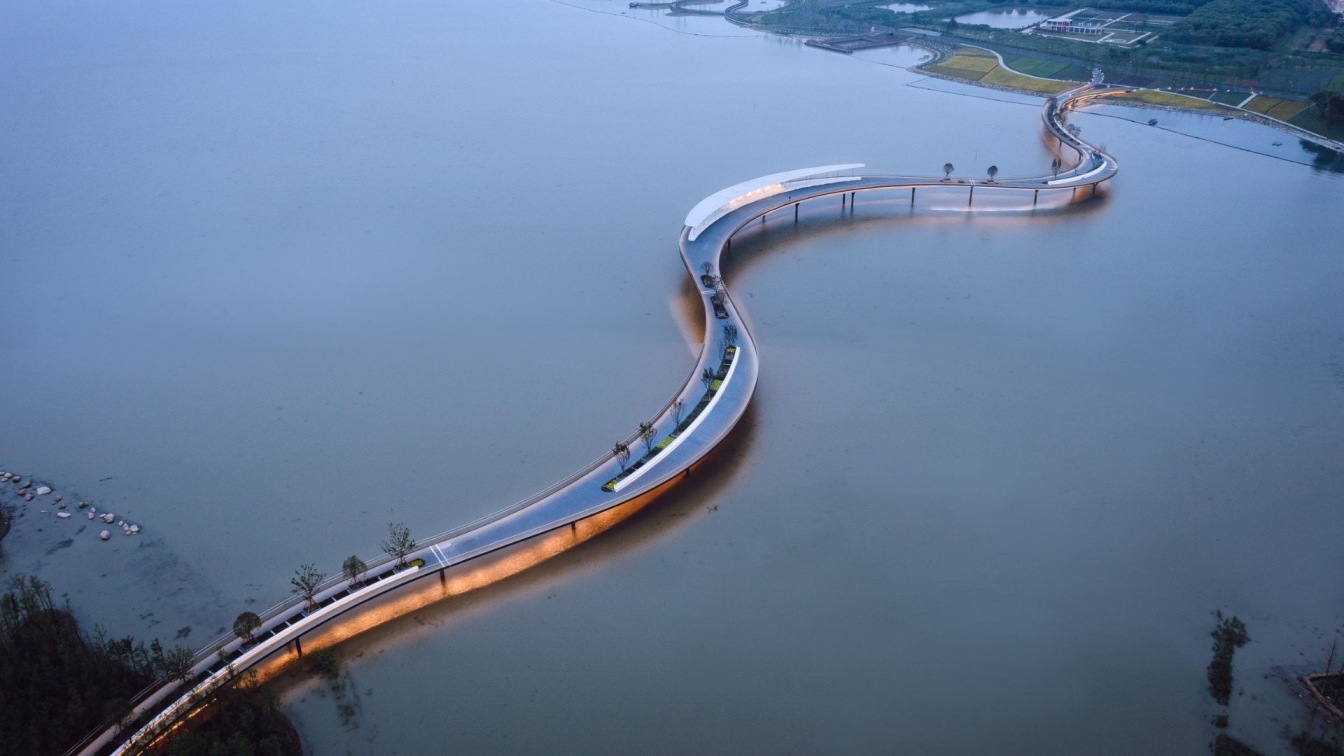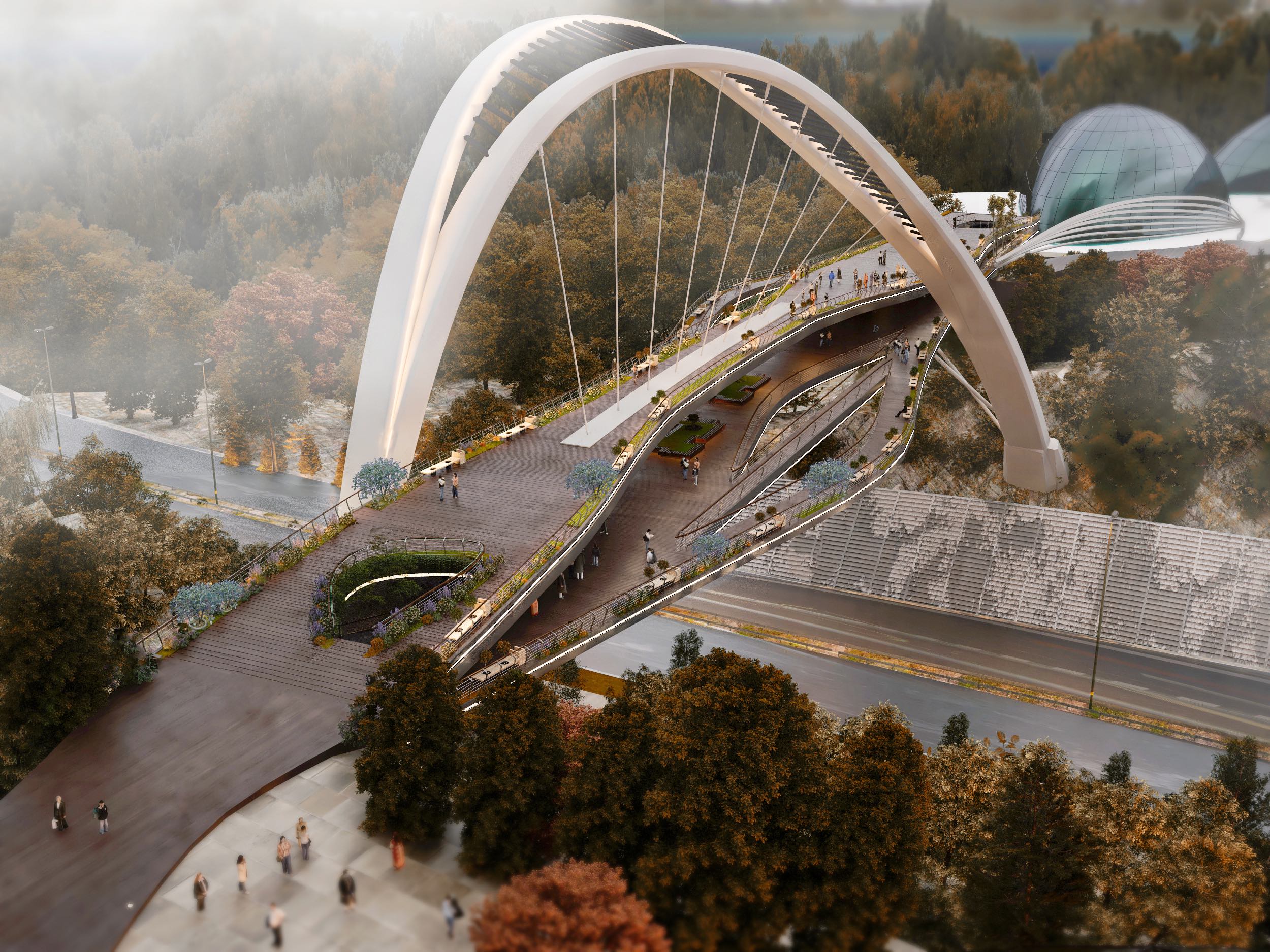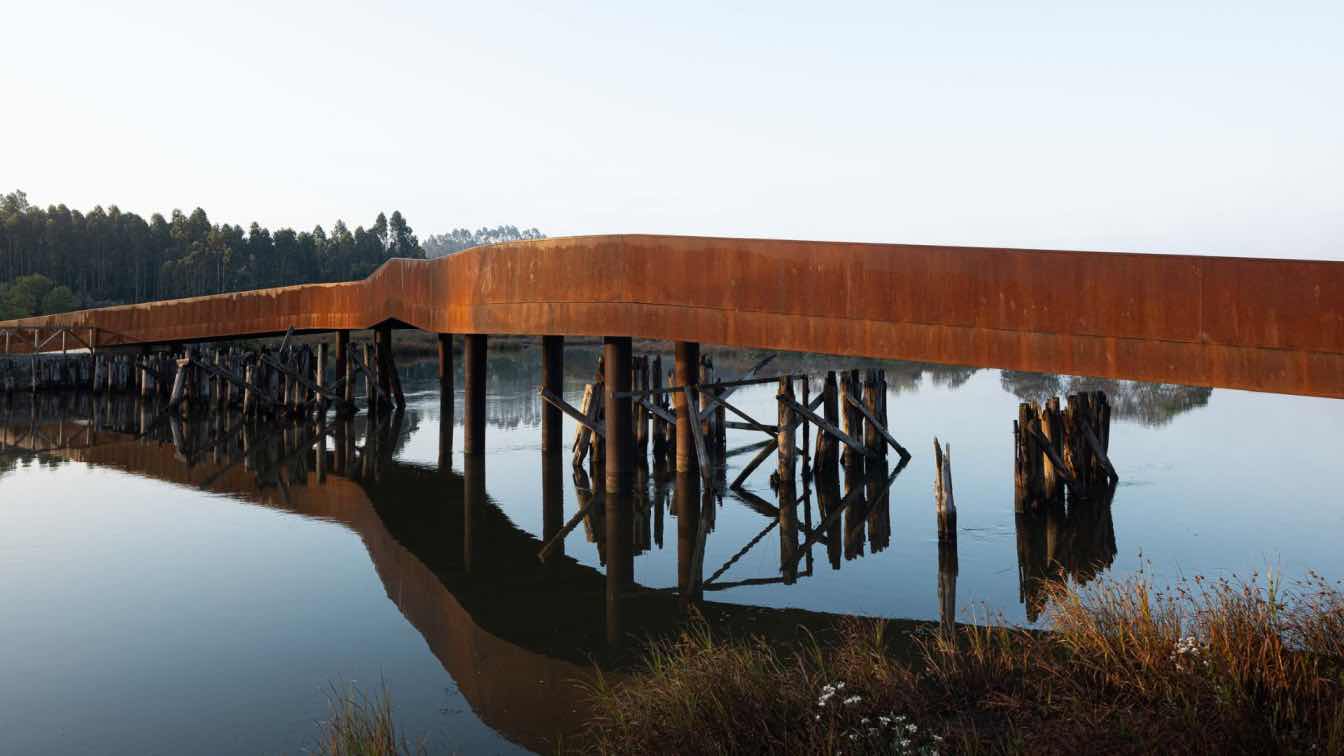Striatus: An arched 3D-concrete-printed masonry bridge, is a project by the Block Research Group (BRG) at ETH Zurich and Zaha Hadid Architects Computation and Design Group (ZHACODE), in collaboration with incremental3D (in3D), made possible by Holcim.
Striatus is an arched, unreinforced masonry footbridge composed of 3D-printed concrete blocks assembled without mortar. Exhibited at the Giardini della Marinaressa during the Venice Architecture Biennale until November 2021, the 16x12-metre footbridge is the first of its kind, combining traditional techniques of master builders with advanced computational design, engineering and robotic manufacturing technologies.
The name “Striatus” reflects its structural logic and fabrication process. Concrete is printed in layers orthogonal to the main structural forces to create a “striated” compression-only funicular structure that requires no reinforcement.
A new language for concrete
Proposing a new language for concrete that is structurally informed, fabrication aware, ecologically responsible and precisely placed to build more with less, Striatus optimises the interrelated properties of masonry structures, 3D concrete printing (3DCP) and contemporary design; presenting an alternative to traditional concrete construction.
Strength through geometry
Striatus is an unreinforced concrete structure that achieves strength through geometry. Concrete can be considered an artificial stone that performs best in compression. In arched and vaulted structures, material can be placed precisely so that forces can travel to the supports in pure compression. Strength is created through geometry, rather than an inefficient accumulation of materials as in conventional concrete beams and flat floor slabs. This presents opportunities to significantly reduce the amount of material needed to span space as well as the possibility to build with lower-strength, less-polluting alternatives.
 image © naaro
image © naaro
Striatus’ bifurcating deck geometry responds to its site conditions. The funicular shape of its structural arches has been defined by limit analysis techniques and equilibrium methods, such as thrust network analysis, originally developed for the structural assessment of historic masonry vaults; its crescent profile encompasses the thrust lines that trace compressive forces through the structure for all loading cases.
Steel tension ties absorb the horizontal thrust of the arches. Neoprene pads placed in between the dry-assembled blocks avoid stress concentrations and control the friction properties of the interfaces, echoing the use of lead sheets or soft mortar in historical masonry construction.
 image © naaro
image © naaro
In plan, the boundaries of the structure form deep arches that transfer horizontal loads (for example, from visitors leaning against the balustrades) to the supports in pure compression. Advanced discrete element modelling (DEM) was used to refine and optimise the blocks’ stereotomy and to check the stability of the entire assembly under extreme loading cases or differential settlements of the supports.
The bridge’s 53 3DCP voussoirs have been produced using non-parallel print layers that are orthogonal to the dominant flow of forces. This avoids delamination between the print layers as they are held together in compression. The additive manufacturing process ensures the structural depth of the components can be achieved without producing blocks with a solid section, hence reducing the amount of material needed compared to subtractive fabrication methods or casting.
 image © naaro
image © naaro
Striatus follows masonry structural logic on two levels. As a whole, the bridge behaves as a series of leaning unreinforced voussoir arches, with discretisations orthogonal to the dominant flow of compressive forces, following the same structural principles as arched Roman bridges in stone. Locally, on the level of the voussoir, the 3DCP layers behave as traditional brick masonry evident in the inclined rows of bricks within Nubian or Mexican vaulting.
Sustainable digital concrete
Circular by design, Striatus places material only where needed, significantly reducing its environmental footprint. Built without reinforcement and using dry assembly without binders, Striatus can be installed, dismantled, reassembled and repurposed repeatedly; demonstrating how the three R’s of sustainability (Reduce, Reuse, Recycle) can be applied to concrete structures.
 image © naaro
image © naaro
Reduce: Lowering embodied emissions through structural geometry and additive manufacturing that minimises the consumption of resources and eliminates construction waste.
Placing concrete only there where needed, 3DCP minimises the amount of material required, while the low-stress, compression-only funicular geometry of Striatus proposes the further development of 3DCP that will enable the use of much lower-strength, less-polluting printable materials.
Compared to embedded reinforcement in concrete, Striatus uses external ties to absorb the thrust of its arched shape and dramatically reduce the amount of steel required. A high carbon-intense material, steel reinforcement (100% recycled) per unit mass is more than ten times that of standard concrete.
 image © naaro
image © naaro
Reuse: Improving circularity and longevity. Unlike conventional reinforced concrete structures, Striatus is designed to be dry assembled without any binder or glue, enabling the bridge to be dismantled and reused in other locations. Its funicular design ensures the 3DCP blocks experience low stresses throughout their use, resulting in no loss of structural integrity. Striatus separates components in compression and tension, ensuring external ties can be easily accessed and maintained, resulting in a longer lifespan for the entire structure.
Recycle: By ensuring different materials are separated and separable, each component of Striatus can easily be recycled with minimal energy and cost. 3D printing also avoids the waste and costs associated with single-use moulds. Additionally, the component materials within Striatus remain separate and separable with the use of mechanical connections such as simple dry contacts between the voussoirs rather than chemical glues or binders, ensuring a simple, low-energy recycling process at the end of the elements’ life, potentially after multiple cycles of reuse.
 image © naaro
image © naaro
Robotic 3D concrete printing
Unlike typical extrusion 3D printing in simple horizontal layers, Striatus uses a two-component (2K) concrete ink with corresponding printing head and pumping arrangement to precisely print non-uniform and non-parallel layers via a 6-axis, multi-DOF robotic arm. This new generation of 3D concrete printing in combination with the arched masonry design allows the resulting components to be used structurally without any reinforcement or post-tensioning.
To prevent misalignment between the direction of structural forces and the orientation of material layers that arises from typical shape-agnostic slicing of explicitly modelled geometry, a custom-developed design pipeline was formulated for Striatus to ensure that its printed layers are wholly aligned with the direction of compression forces throughout the entire bridge and also locally through each 3D-printed block. To address issues and challenges that could prevent in-between stability during printing, the coherence and feasibility of the gradually evolving print paths have been modelled using a Functional Representation (FRep) process.
This process encodes and continuously checks rules of minimum overlap, maximum cantilever between print layers and print length, print speed and the volume of wet concrete extruded. These measures, typically used in horizontally layered 3DCP, have been advanced and refined to work on an inclined-plane setting:
- The angular differences between start and end planes of all 53 printed blocks have been simultaneously adjusted to meet multiple criteria such as an appropriate structural contact and angle between adjacent blocks, and maximum print inclination.
- The careful design and iterative refinement of the hollow cross-sections and infill triangulation have ensured that material is placed corresponding to the precisely analysed, local structural performance of each block. This design and optimisation have been applied to each individual layer of every block (with 500 print layers on average per block), ensuring that all blocks are as hollow and light as possible, and consequently use the least amount of material possible while maintaining structural integrity under all loading conditions.
- The resulting intricate cross-sectional design has been processed into a single, continuous print path meeting various criteria that include appropriate print speed and turning radii, structurally required material width and thickness, and controlled expression of naturally occurring printing artefacts.
 image © naaro
image © naaro
A nuanced aspect of robotic 3DCP masonry is the re-introduction of intelligence and highly skilled labour into the manufacturing and construction industry. The digitisation of fabrication and digital augmentation of skilled assembly and construction techniques makes historically-accrued knowledge accessible to younger generations and enables its systematic upgrade towards industrialised construction through the use of computational and robotic technologies. In stark contrast to a brute force, and often materially wasteful economy biased towards automation and assembly line production, 3DCP masonry introduces possibilities of a symbiotic human-machine economy. This promises an environmentally, socio-culturally and economically sustainable alternative to its 20th-century predecessor.
 image © naaro
image © naaro
Computational design-to-construction integration
Integrating design, engineering, fabrication and construction, Striatus redefines conventional interdisciplinary relations. The precise manufacturing of the blocks was enabled by well-defined data exchange between the various domain-specific software toolchains involved in the process. This co-development approach was facilitated through the use of COMPAS, an open-source computational framework for collaboration and research in the AEC industry, which enabled the fluent interaction among the key players of the project, working together in five different countries, under a very tight schedule and budget, at a time in which travelling was not possible.
 image © naaro
image © naaro
Disruptive outlook
Striatus offers a blueprint for building more with less. Created with the same structural principles and a similar fully-integrated computational design-to-fabrication approach that form the basis of the vaulted, rib-stiffened, unreinforced concrete floors being developed by the Block Research Group in partnership with Holcim, Striatus proposes an alternative to the standard inefficient floor slabs within any building.
Compared to typical reinforced concrete flat floor slabs, this new floor system uses only 30% of the volume of concrete and just 10% of the amount of steel. The very low stresses within the funicular structure also enable the use of low-embodied-carbon concrete that incorporates high percentages of recycled construction waste. Prefabricated and dry-assembled, and therefore fully demountable and reusable, this floor system is easily and cleanly recyclable at end-of-life.
 image © naaro
image © naaro
With an estimated 300 billion square metres of floor area to be constructed worldwide over the next 30 years, and floors comprising more than 40% of the weight of most high-rise buildings (10+ storeys), introducing the principles demonstrated by Striatus would truly disrupt the construction industry — transforming how we design and construct our built environment to address the defining challenges of our era.




















Full credits
Design
- ZHACODE: Jianfei Chu, Vishu Bhooshan, Henry David Louth, Shajay Bhooshan, Patrik Schumacher
- ETH BRG: Tom Van Mele, Alessandro Dell’Endice, Philippe Block
Structural engineering
- ETH BRG: Tom Van Mele, Alessandro Dell’Endice, Sam Bouten, Philippe Block
Fabrication design
- ETH BRG: Shajay Bhooshan, Alessandro Dell’Endice, Sam Bouten, Chaoyu Du, Tom Van Mele
- ZHACODE: Vishu Bhooshan, Philip Singer, Tommaso Casucci
3D concrete printing
- In3D: Johannes Megens, Georg Grasser, Sandro Sanin, Nikolas Janitsch, Janos Mohacsi
Concrete material development
- Holcim: Christian Blachier, Marjorie Chantin-Coquard, Helene Lombois-Burger, Francis Steiner
- LafargeHolcim Spain: Benito Carrion, Jose Manuel Arnau
Assembly & Construction
- Bürgin Creations: Theo Bürgin, Semir Mächler, Calvin Graf
- ETH BRG: Alessandro Dell’Endice, Tom Van Mele
Logistics
- ETH BRG: Alessandro Dell’Endice, Tom Van Mele
- Holcim Switzerland & Italy: Michele Alverdi
- LafargeHolcim Spain: Ricardo de Pablos, José Luis Romero
Additional partners
- Ackermann GmbH [CNC timber formwork]
- L2F Architettura [site measurements]
- Pletscher [steel supports]
- ZB Laser [lasercutting neoprene]
Documentation
- ZHACODE: Jianfei Chu, Cesar Fragachan, Vishu Bhooshan, Philip Singer, Edward Meyers, Shajay Bhooshan
- ETH BRG: Tom Van Mele, Alessandro Dell’Endice, Philippe Block
- In3D: Alexander Gugitscher, Sandro Sanin, Nikolas Janitsch
- naaro
- LBS Fotografia
Fact sheet
Overall
- Maximum height = 5 m
- Minimum head height = 2 m
- Total surface area = 216 m2
- Total covered area = 50 m2
- Longest span = 10 m
- Shortest span = 95 m
- Material density of 3D-printed concrete = ~2350 kg/m³
- Total mass of the structure
- 3DCP blocks = 5 ton
- footings, tension ties = 2 ton
Voussoirs / Blocks
- Number of voussoirs = 53
- Thicknesses of voussoirs = 05m - 0.35 m
- Volume (solid) of voussoirs = 18 m³
3D-printed concrete
- 3D-printing path lengths (per block) = 602 m - 1754 m
- 3D-printing total path length (all blocks) = 58 km
- 3D-printing total print time (all blocks) = 84 hours
(incl. pre-print and post-print procedures) - 3D-printing layer heights = 46 mm - 11.98 mm
- 3D-printed mass per block = 217 kg - 783 kg
- 3D-printing widths
- Deck Blocks = 25 mm - 50 mm
- Balustrade Blocks = 40 mm
Location
- Giardino della Marinaressa, Venice, Italy
- 45°25'53.6"N 12°21'09.8"E





